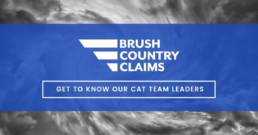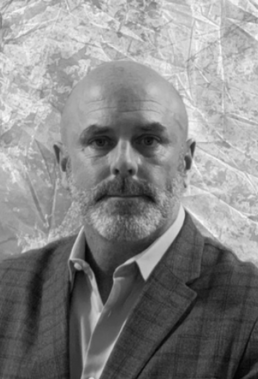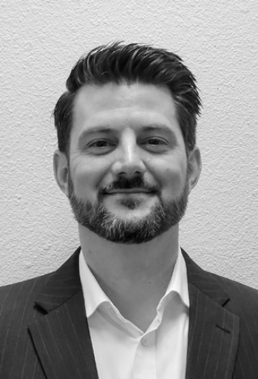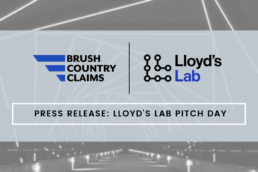Get to Know our CAT Team Leaders

Meet Brush Country Claims Catastrophe Team Leaders!
With hurricane season upon us, we wanted to do a little Q&A with our CAT team leaders to get their take on the evolving industry, see what advice they have for new adjusters, and hear some stories from their own field deployments!

Craig Cunningham
Vice President of Claims

Charlie Day
Catastrophe & HyDAP Director
What led you into claims adjusting?
Craig: That’s an interesting story. You see, I didn’t grow up in an adjusting family nor know anyone who was an adjuster, but one day at the chiropractor’s office, I asked the guy sitting across from me (visibly in a lot of pain) what had happened to him. He replied he had fallen off a roof. I laughed a bit and asked why he was on the roof in the first place.
He replied he was an insurance adjuster. Later that night I googled what an insurance adjuster was, and the rest is history.
Charlie: Up until 2008 I managed high volume nightclubs in Tucson, AZ. The recession set in 2007 and by 2008 I lost my comfy salary and started over. I tried a couple of different other avenues, but the struggle was real.
Lucky for me, I had an uncle that was willing to help me get into insurance adjusting. So, I packed up everything I owned and headed for Texas to work my first storm Hurricane Ike. I never looked back.
What aspect about your position are you most passionate about?
Craig: That’s easy, helping. Helping my pears has been the most rewarding part of my adjusting journey. As I said above, I didn’t have an adjuster mentor when I got into this business and as we all know in the beginning years of this career, it’s sink or swim so helping someone else find their way has been a pleasure.
Charlie: After years in the field, my passion is to help others succeed. Getting a call from an adjuster during a difficult time, knowing exactly what it feels like at that moment, and being able to help push through the challenge gives me satisfaction. I like to be able to pay it forward from everyone that helped me when I was in those exact moments.
What advice do you have for adjusters deploying for their first catastrophe?
Craig: My advice for new adjusters is to slow down. Speed within your process will come with repetition. When scheduling your inspections, start by scheduling out a few days because when making your first contact calls you will get the insured that needs to see you first thing tomorrow and you don’t want to squeeze them in.
You must schedule office days for yourself to catch up on work and health. Listen more then you speak, have compassion and patience for the insured and never discount a concern as no big deal and the best advice I can give is if you find yourself still estimating at 3AM, just stop!
Charlie:
- Do your own thinking. Do not let other parties determine your thoughts while in the field.
- No expectations. Adjust and adapt.
- Do not give up. Push to the end. The reward is worth every minute you put in.
- Never stop learning. There will always be a new scenario that you can learn from and grow your skill set.
- Can you tell us one of your most significant memories from a CAT season?
Craig: The CAT event that taught me the most about being an adjuster was in Atlanta GA. 2006 I believe. Atlanta had been in a drought for a long time leading up to the torrential rain event that was about to take place. If you’ve ever been to the Atlanta area you know the size of trees they have and with that amount of wind and rain the trees fell hard!
Although there were many homes devastated by the fallen trees, one claim stands out. This loss was to a one story residential property with a walk our basement and elevated read deck. In the front yard was a pine tree with a 48in circumference laying in the middle of the house, in the back yard the tree cut through the rear decking and blew out the doors, windows and most of the rear elevation.
Before this loss I had only been running wind and hail claim with a few interior water claims, so to say I was in over my head would be an understatement.
The construction aspect was the easy part, but the part of adjusting I was about to learn changed my view of what a claims adjuster really does. Being an adjuster isn’t just estimating storm related damage, its taking the lead for a person or family sufferings a misfortune with compassion and patience every time.
When I arrived at this loss the husband and wife were still noticeably shaken and were looking at me as the expert coming to help them. We walked the property briefly as I recognized the extent of damage.
I excused myself for a min to reschedule my days remaining claims because this family needed my full attention. We resumed talking and took a seat at the kitchen table. I spent much of the next few hours simply listening, taking notes and learning what was most important to each of them.
The lesson I learned on this assignment was to take the time with your insured and listen to them. You might have seen and estimated similar damage a hundred times, but this is most likely the first time your insured has gone through a situation like this. You’re the expert so be there for them.
Charlie: One of the most unique stories came from my first deployment on Hurricane Ike. We were working Bolivar Peninsula that was completely devastated by storm surge and hurricane force winds. An insured claimed a garage that her detached garage was damaged by wind prior to being swept away by storm surge, and she could prove it.
Come to find out, her neighbor rode out the storm in a nearby tree, and provided a written testimony informing the garage roof peeled off by high wind prior to the storm surge. Needless to say, the roof portion was covered by her wind policy.
How is Brush Country Claims’ CAT department different from other firms you have worked with?
Craig: The first thing that comes to mind is we are all from the field and we know what it’s like out there. We strongly encourage open lines of communication with our inside staff and field adjusters. The BCC staff is here to assist our field adjusters to make the claims process the best it can be for the insured.
Charlie: In 13 years, I have only worked for two other firms besides BCC. With that, I would say what separates BCC from other firms is “Loyalty” to their adjusters in an industry where Loyalty can be a rarity. They do everything ensure you get a fair amount of claims with competitive fee schedules during a deployment to ensure your worth.
What are the biggest changes you’ve seen in the claims industry?
Craig: The biggest changes I see is training and cycle times. When I first started there was little to no training for the field adjuster. In today’s market if the field adjuster wants to advance their skills quicker there are multiple resources for additional training available.
Cycle times early on were important but not like today. In today’s world of instant gratification, the insurance industry, clients, and the insureds are no different.
Charlie: I would say the biggest change since I entered the industry is demand for faster turnaround times. Every year as technology progresses, we contend with the policyholder expectation towards a faster indemnification process. Which is why BCC develops their own technology to keep up with this ever-growing demand.
Related Posts
July 28, 2021
PRESS RELEASE: Lloyd’s Lab Pitch Day
GEORGETOWN, Texas – July 28, 2021 – Brush Country Claims, a Central Texas-based…
June 28, 2021
Rising Building Costs and Insurance Premiums
In the first half of 2021 we have seen a rapid increase in the price of…
June 24, 2021
The Benefits of Remote Work
Healthy culture = healthy employees. We’re proud to say our team at Brush…



